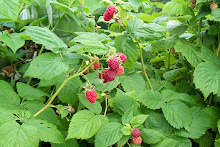 Within all that fluffy fur and munched up soft straw are five little week old bunnies, also known as kits. I have to check the kits regularly to make sure all are getting enough to eat and are doing well. I take each one out and check then put them in a little box and go to the next one.
Within all that fluffy fur and munched up soft straw are five little week old bunnies, also known as kits. I have to check the kits regularly to make sure all are getting enough to eat and are doing well. I take each one out and check then put them in a little box and go to the next one. Here they are in the box after being checked. All have round tummies and seem to be doing great! Two grey, one black, one white and one tan. They're lively and alert. The little tan one seems to be smaller than the others but I hesitate to call him a runt because he is feeding well and is growing. He had a tough start in life.
Here they are in the box after being checked. All have round tummies and seem to be doing great! Two grey, one black, one white and one tan. They're lively and alert. The little tan one seems to be smaller than the others but I hesitate to call him a runt because he is feeding well and is growing. He had a tough start in life. `
This is Caoimhe's (pronounced Keeva) second litter. The first litter was an incredible 12 kits. This time around, Caoimhe had a much more reasonable 6 kits. One was born DOA, that happens sometimes. The little tan one was found outside the nest. He was the first one born. No others had arrived yet. So I kept him warm and dry. The next day Caoimhe had the other 5. I popped the little tan guy in with the rest and everyone's been doing fine since.
I'm wondering if this early birthing of one is hereditary. Ceilidh (pronounced Kay-lee) did the same thing. She didn't do it all the time, just twice. But Ceilidh is Caoimhe's mom. It's not a big deal really when a kit is born earlier than the rest. But I figure it's got to be tougher on the doe and it does make it harder for the kit. When a kit is born before the rest, the mom doesn't pull fur to keep it warm and she doesn't feed it either. She waits till she drops the whole litter before going into 'mom mode'. I'll see how it goes but if Caoimhe does it again, I doubt if I will keep any of her offspring as working does. That would be sad because Ceilidh died last Autumn and after Caoimhe, that would be the last of her line in my rabbitry.

